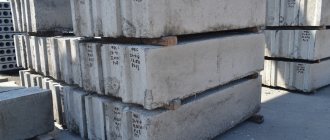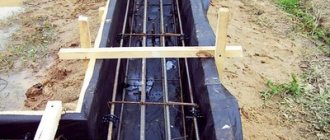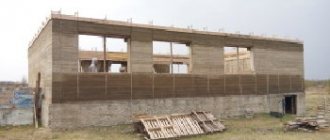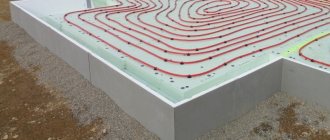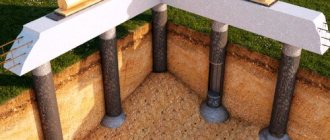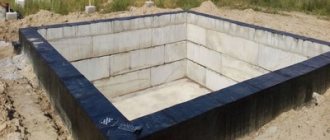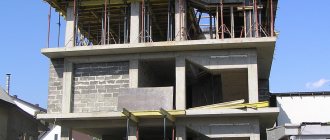The construction of any building begins with excavation work and foundation construction. The result of the construction of the facility and the reliability of its operation will depend on the chosen design solution, material, and method of installation of the base. At the same time, the cost of the building element and environmental safety are taken into account. Satisfying the listed requirements is possible during the construction of the TISE foundation. This type belongs to the group of pile or pile-grillage foundations.
TISE foundation - application
The TISE foundation is a pile-tape type foundation, which is formed from bored piles, widened in the lower part, and a raised reinforced concrete grillage.
Fig. 1.1 : Diagram of the TISE foundation
Such a foundation can be built with only a hand drill TISE F in the arsenal - a structure equipped with a cutting-expansion sleeve, which creates a dome-shaped widening at the bottom of the well.
Expert advice! The TISE method was developed and designed by R.N Yakovlev in the mid-nineties, this abbreviation stands for “Technology of Individual Construction and Ecology.”
The scope of application of TISE foundations is extremely wide; in fact, it is a universal foundation option for any individual construction projects.
The following types of buildings can be erected on the TISE foundation:
- One-story brick houses;
- Two-story buildings made of light materials - timber, logs, foam concrete and frame panels;
- Baths;
- Agricultural and non-residential technical premises - garages, workshops;
- Heavy brick and concrete fences.
In terms of soil conditions, TISE foundations have virtually no contraindications; they have proven themselves well in:
- Clay soil;
- Sandy soils;
- Loess and loam;
- Sandy loam.
The above soil types make up over 90% of all soils in the Russian Federation, which determines the widespread use of foundations built using this technology.
Rice. 1.2 : Scheme of operation of the TISE drill in the ground
The TISE foundation is a good analogue to classic strip foundations on heaving soil. Strip foundations, to minimize the risk of deformation under the influence of frost heaving, must be laid in the soil below the depth of its freezing, which, in most cases, is not economically profitable.
Expert advice! TISE foundations, being much cheaper, demonstrate high stability even in highly heaving soil, while possessing load-bearing characteristics sufficient for the construction of any one-story houses.
Types of grillages
Wood
This type of grillage is chosen when constructing bathhouses from houses made of wood materials and is used when there is a low risk of lifting or displacing TISE supports.
In the standard version, it is laid from laminated veneer lumber or well-dried planed boards, joined vertically using bolts and brackets.
The general requirements of its installation technology include fastening it to steel rods pre-laid in the center of the supports, raising the structure above the ground by at least 150 mm, matching the axes of the supports and the central grillage, and laying a waterproofing layer between the wood and reinforced concrete.
All parts of the wooden grillage undergo mandatory treatment with antiseptics (ideally, impregnation in vats); if there is a high risk of wood rotting, a support board with special slots is laid between the grillage and the support to replace it if destroyed. Concrete
Despite the difficulties of laying suspended formwork, concrete lining with this type of support is considered classic and is chosen more often than others. Structures reinforced with a three-dimensional frame made of metal or composite have maximum strength, while tape with longitudinal individual rods has average strength. A simple monolithic grillage made of concrete with a structure height of at least 10 cm can be poured under the constructed adjustments.
By analogy with supports, work on concreting the grillage is carried out in the warm season; the standard 28 days are allotted for the structure to harden. Mandatory conditions for the technology of pouring reinforced concrete varieties include protection of the metal from external influences, ensured by a sufficient thickness of concrete (from 5 cm). The hardened concrete grillage, if necessary (namely, in the case of erecting walls from timber or porous blocks), is covered with 2 layers of waterproofing materials, coated with mastics or insulated. Iron
The piping with a metal channel or I-beam is chosen if there are high requirements for the strength and stability of the foundation.
In particular, this type of foundation is inferior to reinforced concrete in terms of corrosion resistance and is considered relatively short-lived, but optimal when there is a high risk of supports moving due to frost heaving of the soil. The metal grillage is connected to the support reinforcement by welding and, if necessary, painted with anti-corrosion primers (particular attention is paid to welding areas). Ground-supported and hanging
In the classic version, the TISE foundation has a hanging grillage, with a rise above the ground level of at least 15 cm. With this design, the grillage is not affected by the forces of frost heaving of the soil and the risks of its cracking due to displacement of the supports are minimized.
When conducting construction on highly heaving soils, the close location of the grillage to the ground is considered a violation of technology and is prohibited.
An exception is rarely made - when carrying out work in areas with dry and stable soil (which in turn casts doubt on the advisability of laying a TISE foundation instead of a shallow tape) or when planning to install ground floors in a house.
In the latter case, the grillage is made of reinforced concrete and rests on the ground, provided that the base is properly prepared (namely, backfilling under the sole of a dense sand cushion or laying at least 10 cm of a layer of compacted polystyrene foam). The obligatory concrete blind area poured on top of EPS should not be rigidly connected to a low grillage.
Important!!! Many non-professional construction teams make a grillage resting on the ground on heaving soils (especially in the Moscow region), since it is easier to make. Be vigilant and do not follow the lead of the builders!!!
TISE foundation - advantages
The key advantage of TISE foundations is the simplicity of their arrangement - to build such a foundation you do not need to use the services of third-party organizations; if you have the required equipment and know the methodology, you can do the entire range of work yourself.
The second important advantage is the low financial cost of the project, which is determined by the minimum amount of consumable materials. As an example, let’s look at a comparison of concrete costs for pouring a strip foundation and a TISE base:
- A strip foundation, when laying a strip 30 meters long 70 centimeters deep into the soil (take the standard strip width of 40 cm, for one and a half masonry), requires the use of 8.4 cubic meters of concrete;
- To pour the TISE foundation, which consists of 20 pile supports laid to a depth of 1.2 meters, only two cubic meters of concrete are needed.
The absence of the need to use special construction equipment means that all foundation work can be carried out completely autonomously - there is no need to organize electricity and water supply to the construction site, which also affects financial savings.
Rice. 1.3 : Design diagram of TISE piles
In comparison with classic pile foundations, the TISE foundation is not demanding in terms of project implementation time - while screw and reinforced concrete piles need to be loaded with the weight of the building so that in winter they are not pushed out by heaving forces, the TISE support pillars, due to reinforcements in the lower part, can stand winter and without external load - this is the best option for a foundation for long-term construction, which will be implemented as funds become available.
Concrete structure care
Caring for a concrete structure is necessary to minimize plastic shrinkage of the material, provide protection against premature drying and destruction of structural bonds due to sudden changes in temperature.
To do this, create a moistened compress of sawdust on the surface of the concrete solution and cover it with a film on top . Once every three days, the protective layer is watered with water from a watering can (drip irrigation) and re-covered with polyethylene.
Winter maintenance of concrete involves forced heating using mineral wool or polystyrene foam. Sometimes, for this purpose, antifreeze modifiers are added to the solution when mixing.
After the concrete has gained the necessary strength, construction of the grillage begins using standard technology for a pile foundation with reinforced concrete strip.
TISE foundation - disadvantages
With the correct implementation of construction technology, TISE foundations do not have any significant disadvantages.
Of course, such foundations have limited load-bearing capacity, but if we consider them in terms of their intended purpose - the construction of medium-heavy one-story and light two-story buildings, this is not a disadvantage.
Expert advice! The only actual disadvantage of such a foundation is the impossibility of arranging a basement and ground floor.
It is also worth noting the need for additional insulation of the floor of the house - due to the fact that the grillage in the TISE foundations is raised, there will be a draft between the subfloor and the ground, from which the ceiling will be quite cool in winter. This problem is solved by arranging the intake and thermal insulation.
Rice. 1.4 : Blind area on the TISE foundation
Unlike pouring a foundation strip, the technology of which is extremely simple, drilling wells and subsequent formation of piles is a more delicate work, which, for the first time, is recommended to be performed under the guidance of a knowledgeable person.
Manufacturing of tape circuit
When pouring the grillage, remember that it must be a strong concrete structure, reliably reinforced around the perimeter. Pay attention to the quality of the mixture and the reliability of the reinforcement connections. Sequence of events:
- install and level wooden panels;
- cover the inner surface with plastic wrap;
- install reinforcement cages, connecting them with wire into a rigid contour;
- fix the immobility of the formwork using steel pins and transversely located bars;
- fill the prepared circuit with concrete mortar, remove air from the mass;
- Allow the concrete mixture to harden for 4 weeks.
Foundation marking
Laying out the TISE foundation involves setting up a zero level (a line indicating the height of the grillage above the ground) and laying out the locations for drilling wells.
Expert advice! To mark the places for drilling wells inside the contours of the walls, an additional string is stretched, the design pitch of the support pillars is measured along it, and pegs made of reinforcement or timber are driven in at their locations.
Rice. 1.5 : TISE foundation marking scheme
The work is performed in the following sequence:
- Along the contour of the first wall in the ground, parallel to each other, two fence boards are installed. They should be mounted at a distance of 2-3 meters from the extreme points of the wall.
- Nails are driven into the cast-off material or self-tapping screws are screwed in, and a string is stretched between them, protruding as the outline of the building wall;
- The cast-off is driven into the ground so that the stretched string is located at the level of the design height of the upper edge of the grillage - this is our zero line;
- The next fence board is hammered onto a perpendicular wall so that the twine forms a right angle to the wall with the already marked outline;
- The remaining walls of the house are marked in the same way;
- Next, a distance equal to the thickness of the grillage is set aside from the marking corners, and the internal contour of the foundation is stretched.
Figure 1.6 : Scheme for fastening the bypass boards
Expert advice! To mark the places for drilling wells inside the contours of the walls, an additional string is stretched, the design pitch of the support pillars is measured along it, and pegs made of reinforcement or timber are driven in at their locations.
Drilling wells and pouring TISE piles
Wells for pouring concrete are created using a TISE-F hand drill, which allows you to form a widening with a diameter of 60 cm in the lower part of the well.
Rice. 1.7 : Sequence of arrangement of TISE piles
This stage of construction consists of the following operations:
- According to the completed markings, wells are drilled on the site to the design depth of the support pillars. The expansions are formed one by one, first the expansion blades are set to the first position - this is how you make a recess with a diameter of 50 cm, after which the blades are set to the final position and the expansion is brought to a maximum of 60 cm;
- Next, the body of the pile is reinforced, for this purpose reinforcing bars with a diameter of 12 mm are used. The rods must be the length of the TISE pile itself, so that the protruding rods can be connected to the reinforced frame of the grillage (the height of each rod is 5 centimeters below the zero mark of the grillage). The reinforcement bars are fastened together using transverse jumpers and binding wire;
- The well is partially filled with concrete M250-M300 (so that the concrete fills the widening), after which formwork is installed in the well from roofing felt or roofing felt rolled into a cylinder (the cylinder should protrude above the ground to a height of 15-20 cm), which is filled with concrete to the top cut. To prevent deformation of the upper part, the formwork is tied with wire and sprinkled with soil.
Figure 1.8 : TISE pile formwork ready for pouring concrete
Expert advice! TISE technology methodologists do not recommend installing sand cushions at the bottom of wells, citing the leakage of cement laitance into the sand and, as a consequence, a decrease in the design strength of concrete.
Grillage arrangement
TISE piles are tied with a reinforced concrete grillage raised above the ground to a height of 30-40 centimeters, the thickness of which depends on the design thickness of the walls of the house.
Figure 1.9 : Sequence of work on tying the TISE foundation
Important! The grillage is subject to mandatory reinforcement with a reinforcement frame, while the reinforcement frame of the strapping must be rigidly connected to the protruding reinforcement and piles.
The sequence of work on arranging the grillage is as follows:
- The upper edge of the support pillars is covered with bitumen mastic (any waterproofing material);
- Along the perimeter of the inner and outer contours of the cast-off, wooden stakes are driven into the ground, which will later act as formwork clamps;
- A bedding of sand is made along the entire width of the grillage, the level of which should correspond to the height of the elevation of the piles above the ground - the bedding will hold the grillage until the concrete has completely hardened;
- Planed boards 2-3 centimeters thick or OSB boards are nailed to the installed stakes. The bottom edge of the boards should rest against a layer of added sand;
- The entire length of the formwork is covered with waterproofing material;
- A reinforced frame with two upper and two lower longitudinal contours connected by transverse jumpers is knitted from reinforcing bars; after laying, it must be recessed into the formwork by 4 centimeters on each side;
- The formwork is poured with concrete mixture. After pouring, the concrete is bayoneted with reinforcement, this is necessary to remove the air cavities formed in it.
Rice. 2.0 : Grillage formwork before pouring concrete
Expert advice! Dismantling of the formwork and work on the construction of the walls of the building is carried out no earlier than 28 days after pouring the grillage.
Design work
Carrying out design activities allows the developer to obtain information about the design of the future foundation. At the initial stage of calculations, the load-bearing capacity is calculated, depending on the dimensions and mass of the structure. The following indicators are determined using the calculation method:
- Mass of the building.
The total weight of the structure includes the mass of the walls, floor elements, foundation using TISE technology and the roof. An approximate calculation of the mass of individual elements is made by summing up the weight of the building materials used.
How to work with a TISE drill
- Loads arising during operation.
The total operational loads that the TIS base absorbs additionally take into account the weight of household devices, communications, and furniture located in the building. - The forces perceived by the base due to the mass of the snow cover.
They are determined by calculation, taking into account the roof area and the thickness of the snow layer. - Load-bearing capacity of each support.
It depends on the type, characteristics of the soil, and the size of the support section. When calculating the expected drilling depth, be guided by the level of soil freezing, additionally add 0.2 m to the obtained value.
The development of a plan for the location of piles involves the installation of supporting elements in the corners of the building, as well as in the areas where walls adjoin. Installation of intermediate supports is provided when the interval between piles increases by more than 3 meters.
Knowing the mass of the structure and the load perceived by a support of a certain diameter, it is possible to make a decision on whether the design number of piles corresponds to the mass of the structure. If necessary, you can increase the diameter of the thrust bearing or the number of support posts. The result of the design work is a sketch of the pile field, which is the basis for further stages of work.
TISE piles are the basis of the TISE pile-grillage foundation
TISE foundation - current prices
If you do not have sufficient experience to correctly implement the technology described above, it is recommended to entrust the arrangement of the TISE foundation to professionals.
The average cost of services for the construction of a TISE foundation today is (including work and materials):
- 4-4.5 thousand rubles per linear meter of reinforced concrete grillage.
- 3-3 thousand rubles for the installation of one TISE pile.
When installing a reinforced grillage (the reinforcement frame on each circuit consists of 4 reinforcing bars, and not 2, as in the standard version), its cost increases to 5 t.r./l.m.
A standard foundation for a two-story wooden house with an area of 10*10 sq.m, when ordered turnkey, will cost you around 300-350 thousand. rubles
Reviews of the branded drill
The main questions for developers are related to how realistic it is to drill wells manually using a proprietary drill. Looking at the video, it seems that this task is not easy. But here are some reviews.
The soil on my site is different: some are loam, some are dense clay, and such that you can only chop them with an axe. At first I thought about renting a motor drill, but I decided to try it straight away with a drill. And nothing, not very hard. As a result, I decided that a motor drill would not speed up the process much, so I made all 40 pieces by hand. During the day, 5-6 2-meter wells were produced. They drilled easily, but with expansion it was difficult: I already had dense soil there, and it was difficult to turn with the blade open.
Oleg, Kharkov
I modified the TISE drill I bought: I welded additional teeth, instead of a rope that opens the blade, I adapted a rod - now you can put pressure on it, and not just pull. And most importantly, I lengthened the handle so that two people could turn it. While they were drilling the extensions, they twisted it 90°, but the work became much easier. In general, I'm pleased.
Nikolay, Krasnoyarsk
